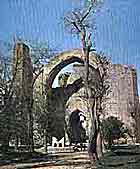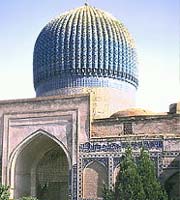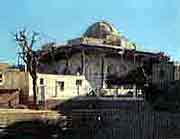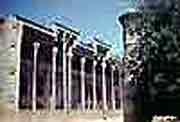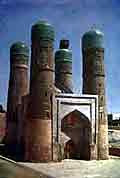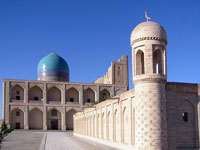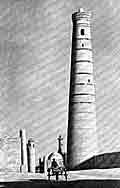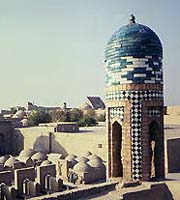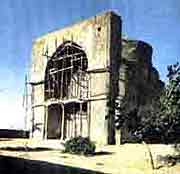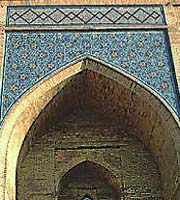Мечети Средней Азии
| Казахстан | Киргизстан |
| Таджикистан | Тукменистан |
Узбекистан
Ислам в Узбекистане
имеет давнюю и богатую историю. Города Самарканд и Бухара являются
центрами традиционной исламской образованности. Кроме того, Бухоро-йе
шариф («благородная Бухара») считается своеобразной столицей суфийского
тариката Накшбандийа. Именно в Бухаре расположено медресе «Мир Араб»,
где проходило обучение большинство мусульманских священнослужителей
СССР. Большая часть населения республики - сунниты ханафитского мазхаба.
Исключение составляет незначительная шиитская община ирани (выходцев из
Ирана) в Самарканде.
Еще в 80-е гг. среди узбеков стали популярны паломничества к могилам
святых - зийарат, обряд исламской свадьбы - никах и прочие
национально-религиозные традиции. Местные власти этому
противодействовали. Вместе с тем партийно-советские органы не только
закрывали глаза на нарождавшуюся активность сторонников т.н. «чистого
ислама» Мухаммада Раджаба, Хаким Кори, Абдували Мирзоева
(предшественников нынешних «ваххабитов»), но и в конъюнктурных целях
предоставляли им возможность выступить в СМИ.
В Ферганской долине (смотри "Фергана"), где проживает около половины населения страны (10
млн. чел.), большая плотность населения выступает как фактор, повышающий
социальную и религиозную коммуникативность людей. Именно здесь в начале
перестройки был особенно силен исламский радикализм. В декабре 1991 г.
президент Узбекистана И.Каримов под давлением оппозиции на митинге в
Намангане даже обещал построить в стране исламскую республику. Боевые
исламистские отряды «Адолат» («Справедливость») тогда занялись
«наведением общественного порядка», следили за исполнением норм шариата.
В 1993 г. власти Узбекистана жесткими мерами положили двоевластию конец.
Лидеры оппозиции Тахир Юлдашев и Джума Намангани вынуждены были
эмигрировать из страны. Большая часть оппозиционеров обосновалась в
соседних Таджикистане и Афганистане, где ими было создано «Исламское
движение Узбекистана» (ИДУ), имеющее откровенно экстремистский характер.
Узбекским руководством был взят курс на построение светского государства
в духе Кемаля Ататюрка и неоджадидизма («светский путь в исламской
культуре»). Сочетанием репрессивных мер с политикой содействия
исламскому просвещению (в стране было построено 2000 мечетей, 10
медресе, открыт Исламский институт) удалось добиться снятия
напряженности.
Однако крайне низкий уровень жизни в Ферганской долине, массовая
безработица среди молодежи заставляют часть молодых узбеков
прислушиваться к проповедникам «исламского социализма». В стране наряду
с «ваххабитами» действуют еще две подпольные группировки поклонников
«чистого ислама»: «Хизб ут-тахрир», «Акрамийа».
Снятию напряженности в конфессиональном вопросе мог бы способствовать
диалог правительства республики с традиционалистским и суфийским
духовенством.
Самарканд - один из древнейших городов мира, имеющего возраст более 2500 лет. Город был столицей могущественного в древности государства Согд, центром обширной империи Тамерлана (Тимура). По своей исторической и архитектурной значимости он не уступает всемирно известным древним центрам мировой цивилизации. Общеизвестна площадь Регистан с тремя древними медресе(Улугбека, Шир - Дор, Тилля - Кари). Неподалеку мавзолей Гур-Эмир, усыпальница Тимура и его сыновей и внуков, который послужил образцом для постройки мечети в Санкт-Петербурге в 1914 г. Прекрасные изразцы в мавзолеях города мертвых - Шахи-Зинда. Самая большая среднеазиатская мечеть Биби-Ханым, которая была построена в XIV веке и сразу же начала разваливаться, сейчас это полуразрушенное сооружение. Рядом с ней огромный базар, тоже самый большой в Средней Азии.
|
|
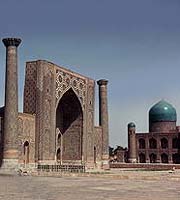 Регистан |
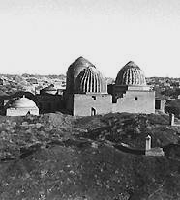 |
ШАХИ-ЗИНДА (перс., букв. — живой царь), памятник средневековой архитектуры в Самарканде (Узбекистан), ансамбль мемориально-культовых построек (в основном 14-15 вв.) с керамическим многоцветным декором: мазар Кусама ибн Аббаса (14 в., декор 15 в.), портально-купольные мавзолеи — Шади-Мульк, Хаджа-Ахмада (оба — 14 в.), комплекс Туман-Ака (нач. 15 в.; чартак — 4-столпный купольный павильон, мавзолей, мечеть), т. н. мавзолей Казы-заде-Руми (15 в.). |
|
|
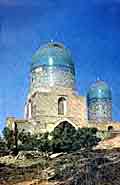 Мовзолей Казы-Заде-Руми |
|
|
Гур-Эмир был выстроен по приказу Тимура в построенном в конце 14 века ансамбле медресе и ханаки Мухаммеда-Султана (сохранились частично). Мавзолей, украшенный глазурованным кирпичом и керамической мозаикой, поражает многоцветностью декора и величественной монументальностью объема. В интерьере — панель из оникса, полихромная роспись, надгробия из мрамора и черно-зеленого нефрита. |
Бухара - один из старейших городов Средней Азии, имеющий более чем 2000-летнюю историю, в прошлом был столицей Бухарского эмирата.В центре города возвышается древняя цитадель - арк, самый древний его археологический памятник. Концентрация древних мечетей, медресе, караван-сараев и торговых куполов в центре просто неимоверная. Но, особое место в облике Бухары занимает построенный в 12 веке минарет Калян (Большой минарет). Высота его - 50 метров. Это самый высокий из известных архитектурных памятников Средней Азии. Прекрасно сохранились мечети Магоки- Аттари, Боло-Хауз, Балянд, Ходжа -Зайнеддин, мовзолей Исмаила Самани (9 - 10 вв.), медресе Кукельдаш, Улугбека, Кош-медресе, Мири-Араб(лучшее действующее духовное учреждение в Средней Азии). В Бухаре жили и творили выдающиеся поэты - Фирдоуси, Рудаки, всемирно известный ученый Ибн - Сина (Авиценна).
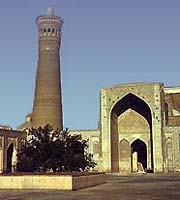 Минарет Пои Калян |
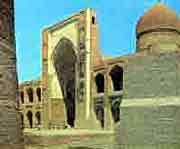 Мири - Араб - медресе (1536 г.),построенное на деньги , вырученные от продажи в рабство персидских военнопленных Убайдуллой-ханом (Инф. С. Кожевникова) |
|
Мечеть Балянд |
КАЛЯН
(Пои-Калян), ансамбль городской
площади в Бухаре (Узбекистан),
памятник средневековой архитектуры
Ср. Азии, включает: минарет Пои Калян (1127),
мечеть Калян (в современном виде —
1514) с 4-айванным прямоугольным двором,
обведенным купольными галереями (288
куполов), вмещает 10 тысяч молящихся, и медресе Мири-Араб (1535/36) с
парадной усыпальницей и пышным
декором.
|
|
Боло - Хауз |
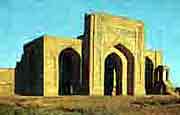
Намазга |
|
Ходжа - Зайнеддин |
Хива - огромный архитектурный заповедник. Первое упоминание о Хиве относится к 10 веку( в трудах арабских путешественников Истахри и Макдиси). В 17 веке город превратился в столицу Хивинского ханства и долгое время был одним из крупных духовных центров мусульманского мира. Из сохранившихся мечетей, мовзолеев и медресе, наиболее примечательны остатки дворца Пахлаван Махмуда, медресе Аллакули-хана,Мухаммед-Амин-хана, минареты Калян, Исламходжа, Кальта-минор, мечеть Магоки - Аттари.
|
Калян |
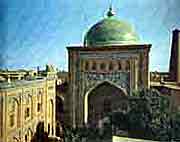
Магоки - Аттари |
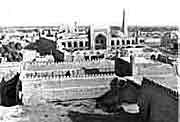
Хива |
|
Шахрисабз - этот город является родиной Тимура. Своеобразный архитектурный музей с сооружениями 14-15 вв. Наиболее примечателен из них Ак-Сарай, бывший дворец Тимура, мечеть Кок - Гумез и др.
|
|
|
||
|
ТАШКЕНТ, столица (с 1930) Узбекистана, центр Ташкентской обл. Железнодорожный узел. 2113,3 тыс. жителей (1991; включая населенные пункты, подчиненные городской администрации, 2119,9 тыс. жителей). Архитектурные памятники: мавзолей Шейхантаур (15 в.) и Каффаль Шаши, медресе Барак-хана и Кукельташа (все 16 в.). В 1966 сильно пострадал от землетрясения. Восстановлен во 2-ой пол. 1960-х — нач. 70-х гг.
ТЕРМЕЗ, город (с 1929), в Узбекистане, центр Сурхандарьинской обл., порт на Амударье. Архитектурные памятники 1-3 вв. (буддистский культовый пещерно-наземный комплекс Кара-Тепе) и средних веков (остатки феодального города 9-12 вв.; мазар Хакима ат-Термези, 11-15 вв.; ансамбль мавзолеев Султан-Саадат, 11-17 вв.). КАРШИ (в 1926-37 Бек-Буди), город (с 1926) в Узбекистане, центр Кашкадарьинской обл. Железнодорожный узел. 168 тыс. жителей (1991). Возник в 14 в. Мечеть Кок-Гумбез (кон. 16 в.). КОКАНД, город в Узбекистане, Ферганская обл., в низовьях р. Сох. Архитектурный памятник 18-19 вв. (Медресеи-Мир, кон. 18 в.; ансамбль Дахмаи-Шохон, 1825; дворец Худояр-хана, 1871). НАВОИ (до 1958 пос. Кермине), город в Узбекистане, Бухарская обл. Назван по имени узбекского поэта Навои. Близ Навои — мавзолей 10-11 вв. и ханака 1558/59. |
|||
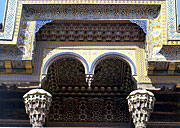
Bala-Haus Mosque, Bukhara.
Our historical Route passes through the northern branch of Great Silk Route, bustling here from China to Europe a thousand years ago. You are promised surprising discoveries, Remnants of ancient palaces and fortresses, the biggest desert in Central Asia, Kysyl - Kum and old world - famous town: Khiva, Bukhara, Samarkand and Tashkent. Along the Route you'll cross the boundaries of 3 Central Asian States (Uzbekistan, Kyrgyzstan, Kazakhstan) and get acquainted with the culture and lifestyle of local people.
NORTH WAYS OF GREAT SILK ROAD
Our historical Route passes through the northern branch of Great Silk Route, bustling here from China to Europe a thousand years ago. You are promised surprising discoveries, Remnants of ancient palaces and fortresses, the biggest desert in Central Asia, Kysyl - Kum, and old world- famous town - Khiva, Bukhara, Samarkand and Tashkent. Along the Route you'll cross the boundaries of 3 Central Asian States (Uzbekistan, Kyrgyzstan, Kazakhstan) and get acquainted with the culture and lifestyle of local people.
TASHKENT
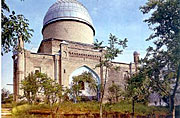
Zainaddin-Bobo Mausoleum is one of the largest sights in Tashkent (XVI с)
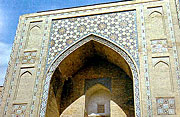
Kukeldash Madrasah XVI с
Tashkent is the capital of Uzbekistan with a population of more than 2,3 million people, the town has 20 centuries of history. It lies on the northern part of the Great Silk Route. In the Middle Ages, Tashkent became the centre of an agriculture oasis, a town of handicraft and arts, a mighty fortress on the northern border with nomadic tribes.
The Barak - Khana (a residence of the Mufti - the Father of the Central Asian Muslims - is situated there now), the Kukeldash Madrasah,the Djami mosque and the Kaffal-Shashi mausoleum still remain. After the terrible earthquake of 1966, the town was practically ruined.Tashkent was revived from ash and became one of the most beautiful towns of Central Asia and a cultural, scientific and the biggest industrial center. Tashkent is the greenest town of Asia with lots of parks,fountains and multi- coloured bazaars and harsh administrative buildings. The lines of the Tashkent metro - the only metro in Central Asia - stretch on 47 km, and by the richness of the marble decoration of the stations, they are considered to be the most beautiful in the world. Hundreds of international meetings, simposiums, congresses and film-festivals are conducted in Tashkent annually. Tashkent is twinned with the 10 major cities of the world (Seattle, Scople, Karachi, Patiala, etc.).
Tashkent is the international air gate of Uzbekistan and Central Asia and is connected with direct flights to more than 15 countries of the world.SAMARKAND
It was even many centuries ago when Samarkand located on the tradecaravan routes, became one of the centers of ancient civilization and is considered to be the model of historical and cultural traditions of the people of Central Asia.
The magnetic force of Samarkand is great.One can't deny the fact that there are very few towns in the world more than twenty five centuries old, towns which could attract people by its beauty, by its unique appearance in the way that Samarkand does. Connected with Samarkand are the names of such great people as Alexander the Great who came to Central Asia, arab commander Kuteiba ibn Muslim, who captured the town during cruel fights, ferocious Genghis-Khan who turned the town into ruins and Tamerlan who created the huge Empire that stretched from the Volga to Gang,from Tien-Shan to Bosfor. Everybody who visits the town admires the high skill and artistic talent of ancient architects who created such architectural wonders like the Shakhi-Zinda ensemble, the Bibi-Khanym mosque, Gur-Emir and Shirat-Khana mausoleums which greatly impress tourists. The heat of old Samarkand is surrounded by grand buildings from three sides - Registan square - attrats great attention and is considered to be the example of town-planning culture of past centuries, Ulugbek madrasa, Sherdor and Tillya-Kari madrasas. A really wonderful change happens - the ancient town comes to life right in front of your eyes and you are sure to have the feeling that nothing in history disappears without leaving a trace.
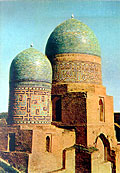
Registan Square (XV-XVII cc.)-the official center of Tamerlan's Empire. The Square is surrounded by the madrasas of Ulugbek,Sher-Dor,Tillya-Kari. All the buildings are notable for their grandious size, luxurious decoration, rich facings with ornaments from glazed brick, mosaic and marble. The Registan Ensemble has remained in its primordial appearance and is considered to be one of the most amazing architectural monuments in Central Asia
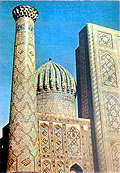
Gur-Emir mausoleum (XV c.) - the Timurids' dynastic burial-vault - a unique monument of Central Asian architecture, a blue ribbed tessellated dome that can be observed from anywhere in town. Here lies the body of "Iron" Tamerlan and his grandson Ulugbek
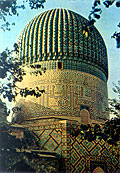
Shakhi-Zinda mausoleums ensemble (XIV-XV cc.) - called "the town of the dead" - is a complex of more than 20 buildings-mausoleums(necropolis) of different ages - a unique museum of glazed decor under the open sky
The tour also include: § Bibi-Khanum cathedral mosque (XIV-XV cc. ) - was built by the order of Tamerlan and was the biggest cathedral mosque on the whole muslim Orient. Thousands of architects, masters, craftsmen and painters from many countries created this complex - the square of which is 130 x 100 m - in only 5 years.Unfortunately, during the earthquake, the dome of mosque was destroyed. At the moment the whole complex is under restoration. § Ulugbek Observatory (XV c.) - only part of the marble sextant of the unique erection 30-meters high and 50-meters in diameter has remained till nowadays. The sextant helped Ulugbek to make the most exact astronomical catalogue with coordinates of 1018 stars. The memorial museum of Ulugbek has been constructed near the Observatory. § Afrosiab-town - the oldest part of Samarkand dated V-III BC. City gates 13m high,interesting samples of earthenware crockery, terracotta statuettes, fragments of ossuaris (ceramic boxes in which the bones of dead people were kept), glassware,pieces of jewellery,coins and the most importantly ,unique frescos were excavated here are now on show in the museum of history of the town and in the Hermitage.
Additional tours: § The theatre of national costume (an exhibition of costume of local inhabitants from Zaroastrinism up to modern times); § Light-sound panorama on Registan Square - a wonderful evening show , where the centuries - old history of the town around the buildings of Registan square. The story is accompanied by light-music effects; § Evening in a national house - visit to a typical Uzbek house,acquaintance with the way of life and traditions of local people, dinner according to the rules of Oriental etiquette, 5-6 dishes of national cuisine, fruits, vegetables and oriental sweets; § Visit of the oldest winery in Central Asia including tasting of local sorts of wine and cognac that have been rewarded by numerous medals of international exhibitions; § One-day excursion to Shakhrisabz - Tamerlan's motherland, ruins of Ak-Sarai (XV c.), necropolis Daraut; § Trip to the mountain of Zeravshan ridge. Walks in picturesque mountains with picnic; § One-day excursion to Pendjikent (50 km,Tadjikistan); § Sightseeing: Khazret-Khyzr mosque (XIX c.), Bibi-Khanum mosque (XIV-XV cc.), Bibi-Khanum mausoleum (XIV-XV cc), Rukhabad mausoleum (XIV c.), Aksarai mausoleum (XV c.), Khodja-Nisbatdor mosque and minaret, Abdi-Darun mausoleum (XV c.) and Ishrat - khana mausoleum (XV c.)
BUKHARA
Bukhara is one of the most ancient towns of the Orient. It grew and developed continuously on the same site from IV B.C.
The
main feature of the town is a rare combination of architectural buildings
of different ages -madrasahs,mosques,
caravan-sarais,baths,rows of traders, minarets and palaces. More than 400
monuments of ancient culture (VI-XX cc.)
are situated in Bukhara. Among them world-famous Ensemble Pan-Kalyan,
complex Lyabi-Haus, Ismail Samami mausoleum and necropolis Chor-Bakr among
others.
In the middle ages, Bukhara was one of the centers of Oriental science and
art, where world famous scientists, writers and painters worked, including
the poet Rudaki and the scientist-encyclopaedist Avicenna. Since time
immemorial, Bukhara has been famous for its gold-embroidery, silk-weaving,
caulkers, potters, blacksmiths, the works of which tourists can purchase.
Today near the ancient monuments, the modern town has grown with its broad
prospects,green parks and fountains, colorful Oriental bazaars and museums.
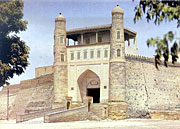
Ark Fortress (VI-XIX cc.).In middle ages it was a whole town with the Emir's house with his wives, mosques, mint place, government institutes, store-rooms,a prison and a square for public executions
KHIVA
The time of Khiva's foundation, lost in ancient days, has turned into a legend. Khiva reached heyday in the Middle Ages having become one of the main towns and later capital of the powerful State of Khorezm. The town was destroyed and reconstructed more than once and the final architectual appearance of the old part was built during XVII-XIX cc. Khiva is called " the unique museum-town under the open sky ". Mosques, madrasas, caravanserais, numerous minarets and palaces of former khorezm lords produce a lasting impression. In contrast to other towns of the Orient, the monuments of ancient architecture were not dot around the city but were concentrate on a small square in the central part of town. Khiva's architecture is striking due to its simplicity and monumental forms, unique and graceful fretted wooden columns, skilful plaiting design that decorated numerous administrative and religious buildings of unique colourful majolica. Khiva carpets, hand-made embroidery, ceramics and copper coining made by local masters, that are kept and passed on from one generation to another are known all over the world.
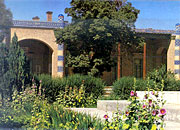
Nurulla-Bai Palace in Khiva
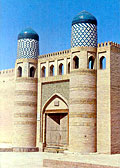
Kunya-Ark (XVII c.) - an inner fortress with administrrative buildings, gunpowder works, arsenal, palace, law-court, mint place, mosques and Kurnysh-Khana palace for official receptions with throne-room decorated with fret plaster (ganch), khans's harem.
More than 40 unique monuments of ancient architecture and arts and crafts are concentrated on the 25 hectare square. The most attractive ones are:
- Djuma mosque (X - XVIII cc.) - a cathedral mosque, the roof of which lies on 212 wooden fretted columns with unique acoustics and original technical ideas of natural lighting;
- Mausoleum of Seyid Alaudina (XIV c.) wuth its gravestone made from coloured majolica is unique among world architectural ceramics.
- Kunya-Ark (XVII c.) - an inner fortress with administrrative buildings, gunpowder works, arsenal, palace, law-court, mint place, mosques and Kurnysh-Khana palace for official receptions with throne-room decorated with fret plaster (ganch), khans's harem.
- Tashkhauli palace (XVII-XIX cc.) - a fully preserved monument of civil architecture created by the best masters of Khorezm with rich decorative ceramic finishing and fretted columns.
- Pakhlavan - Makhmud complex ( XIV-XIX cc. ) - the most remarkble architecture memorial complex in Khiva with an interior entirely covered in unique tiles.
- Islam - Khodja minaret and madrasah ( 1908 ) - 45 m high,is the highest building in Khiva with its observation area from where one can see the whole town.
Авторское
право © 2002 Cайфутдинов Рашид Фатыхович
Обновлено: 03 января 2006
.jpg)
